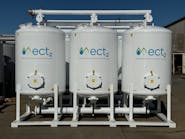Emerging contaminants, as a general matter, have dominated the landscape of drinking water regulatory compliance for the last several years.
Per- and polyfluoroalkyl substances (PFAS) and 1,4-dioxane have become a heavy focus on systems of all sizes. Complicating the issue, individual states have begun enacting varying regulatory limits — which typically fall significantly below the Federal EPA lifetime health advisory limitations — for some or all of the same compounds. These contaminants have major implications for the health of communities across the country and should be top of mind for all water suppliers.
As part of proactively planning for new regulations, water suppliers and purveyors should be informed on the challenges others have faced and ways to mitigate those challenges.
Many states in the Northeast have developed their own approaches to emerging contaminants. While the solutions are not one-size-fits-all, there are lessons to be learned in each case.
PFAS in New Jersey
PFAS are a group of man-made chemicals that are linked to adverse health effects. Widespread detection of PFAS in drinking water has caused the United States Environmental Protection Agency (EPA) to examine whether more stringent regulations should be enacted. To date, no Federal Maximum Contaminant Level (MCL) has been enacted — but EPA has come forward with a health advisory stating an MCL of 70 parts per trillion (ppt).
The State of New Jersey is among several states that have enacted local regulations regarding PFAS. When the state set PFAS MCLs in the first quarter of 2021, water suppliers were tasked with bringing their water into compliance. Compliance in the state is determined by taking a running annual average of quarterly samples.
Atlantic City Municipal Utility Authority (ACMUA), like many other suppliers, was challenged by these new regulations. Atlantic City has two sources for their water supply: surface and groundwater. The wells established in this municipality are located along a lake bordering the Atlantic City International Airport. Testing of several wells revealed PFAS levels which required emergency action on the part of the ACMUA to achieve compliance.
H2M was tasked with developing an emergency PFAS treatment for the Authority to assist in ensuring compliance. To achieve this, H2M consulted with the ACMUA to manage the source of their water and to deploy granular activated carbon (GAC) treatment to three selected wells along the bank of the lake.
Striving to meet the established compliance schedule, H2M leveraged their previous experience in treating chemicals in this family, prior established relationships with manufacturer partners, and ACMUA’s existing equipment. The success of this endeavor required the selected contractors and equipment to come together at the right time, ensuring all pieces were in place for rapid deployment.
H2M assisted in the permitting process as well, often a challenge for any large-scale project of this nature. To establish a positive relationship from the start, New Jersey’s Department of Environmental Protection (NJDEP) was engaged prior to submitting paperwork. This allowed the permitting process to run smoothly, with NJDEP working as a partner.
Working collaboratively with regulators, ensuring they are apprised of all critical project elements and the design approach is vital to the success of emergency projects. The strategy used in this specific instance can be duplicated in any state, significantly improving the efficiency of rapid deployment.
1,4-dioxane On Long Island
PFAS are not the only contaminants that pose challenges to water suppliers. 1,4-dioxane is one of the more challenging contaminants to remove from water, as conventional filtration is generally ineffective.
The contaminant was first identified as a concern in drinking water in 2012, when the Environmental Protection Agency (EPA) released its Unregulated Contaminant Monitoring Rule 3 (UCMR3).
Historically, 1,4-dioxane was used as an industrial solvent stabilizer and could be found in products like paint and degreasers. Today, 1,4-dioxane usage has been greatly reduced, but there remain legacy usages in many household products including shampoos and dish soaps.
On August 26, 2020, a ‘first in the nation’ approach to establishing an MCL for 1,4-dioxane was published in the New York State Register. The MCL was set to 1.0 part per billion in drinking water, following an announcement made by the New York State Department of Health (NYSDOH) in 2017. It was effective immediately, with a 60-day period for sampling.
Though widely spread across the United States, 1,4-dioxane was most concentrated amongst Long Island groundwater supply wells. The contaminant flows directly into the area’s groundwater through septic tanks and cesspools, which eventually flow into surface waters and aquifers — the sole source of Long Island’s drinking water.
H2M, representing over 40 water districts on Long Island, researched the best treatment systems alternatives available. The group reviewed variations of aqueous phase oxidation (AOP) technologies with various UV equipment manufacturers that could be utilized on Long Island groundwater.
To evaluate these technologies, the following five criteria were considered:
- Ability to remove 1,4-dioxane from the source water
- Ability to provide treatment without harmful by-product formation
- Ease of scaling up to meet full-scale flow requirements
- Consistently and effectively treating 1,4-dioxane to treatment goals (non-detect) over various water sources
- Economic feasibility for future potable drinking water treatment
H2M performed an accelerated pilot testing program (in advance of anticipated state regulations) at almost 50 locations across various water suppliers. The program helped conclude that a low pressure UV/H2O2 AOP system was the most viable option for Long Island’s water districts.
The problem on Long Island was pervasive, with several wells exceeding the proposed contaminant levels for 1,4- dioxane. Faced with a compressed schedule before the MCL became effective, and nearly two dozen emergency treatment systems needed over 12-18 months, it was apparent that a typical design/construction plan would not work. Some water suppliers with wells that exceeded MCLs risked losing the ability to meet their peak demands. Since Long Island relies solely on groundwater, this would have caused a major disruption in the communities served by these suppliers.
Working with clients, vendors, and contractors, H2M developed a design and construction approach that condensed the construction period from 18 to 6 months — allowing emergency treatment systems to be rapidly deployed and operational. The standardization of equipment was one of the ways the timeline of the project was reduced.
The approach included:
- Taking advantage of existing chemical transfer stations, so that installations needed minimal additional work through value engineering.
- Working with a water instrumentation vendor developing an analyzer to measure hydrogen peroxide. The H2O2 analyzer, produced in Belgium, had a lead time for each unit of eight to 10 weeks. With the AOP boxes already in fabrication, H2M coordinated a bulk purchase of analyzers to ship to the skid manufacturer for installation rather than waiting for the onsite emergency contractor to order/install. Purchasing in bulk enabled H2M to reserve a block of fabrication time and receive equipment on schedule while saving costs.
- Standardizing the vessel design for the GAC filtration systems to increase flexibility for use at various sites, similar to the containerized skid for the UV chamber. H2M worked with GAC vendors to modify their systems to reduce pressure losses so existing pumps and production flow rates could be maintained.
The standardization of equipment also allowed the development of drawings and technical specifications for regulatory submission and construction more efficiently, reducing a typical four-to-six-month process to only six weeks. A standardized design was then developed to reduce strain on regulatory review by NYSDOH, which was the final part of the design plan, to allow for consistency between sites; and make emergency contractors more efficient.
H2M has developed and successfully implemented rapid deployment for emerging contaminants for numerous water suppliers in New York and New Jersey. A carefully applied, integrated modular design scheme allows a project approach to be adjusted to fit specific needs and unique water quality in any geography across the nation. Regardless of what water quality problems arise because of new regulations, when science and ingenuity are paired, there is always a viable solution. WW
Published in WaterWorld magazine, February 2022.




